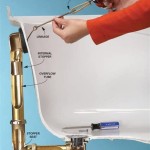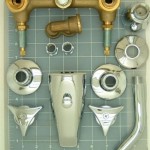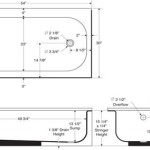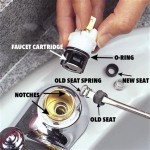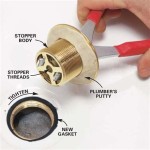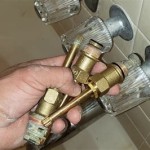How to Clean Your Bathtub Drain
A clogged bathtub drain is a common household nuisance, often resulting in slow draining or standing water after bathing. This blockage is typically caused by an accumulation of hair, soap scum, skin flakes, and other debris that gradually accumulate in the drainpipe. Addressing this issue promptly prevents more significant plumbing problems and restores the bathtub to proper working order. Several methods exist for clearing these obstructions, ranging from simple home remedies to specialized tools and chemical drain cleaners. Understanding the underlying causes of drain clogs and the effectiveness of different cleaning techniques allows for informed decision-making when tackling this maintenance task.
The frequency with which a bathtub drain requires cleaning depends on several factors, including the number of occupants in the household, the length and thickness of their hair, and the amount of soap and other bathing products used. Regular preventive maintenance, such as using a drain strainer to catch hair and debris and periodically flushing the drain with hot water, can significantly reduce the likelihood of clogs forming. Recognizing the early signs of a developing clog, such as slower draining than usual or gurgling sounds coming from the drain, is crucial for addressing the problem before it becomes more severe and difficult to resolve.
Identifying the Cause of the Clog
Before attempting to clean a bathtub drain, it is beneficial to identify the likely cause and location of the clog. The majority of bathtub drain clogs are located relatively close to the drain opening, often within the first few inches or feet of the drainpipe. Common culprits include hair that has wrapped around the drain stopper mechanism or lodged within the drainpipe, and a build-up of soap scum, which can solidify and adhere to the pipe walls. Other potential causes include small objects that have fallen into the drain, such as pieces of soap, shampoo caps, or even children's toys. Investigating the physical characteristics of the drain blockage aids in selecting the most effective cleaning method. For example, a clog primarily composed of hair may respond well to a tool designed to grab and remove hair, while a buildup of soap scum may be more effectively dissolved with a chemical drain cleaner or a solution of hot water and vinegar.
The presence of foul odors emanating from the drain can also provide clues about the nature of the clog. Decaying organic matter, such as hair and skin cells, can produce unpleasant smells, indicating the need for a thorough cleaning that includes disinfecting the drainpipe. If the odor is particularly strong or persistent, it may suggest a more significant blockage that requires professional plumbing assistance. Additionally, if multiple drains in the bathroom are experiencing similar issues, it could indicate a blockage further down the drainage system, possibly in the main drain line, rather than a localized clog within the bathtub drain itself.
Effective Cleaning Methods
Once the likely cause and location of the clog have been assessed, several cleaning methods can be employed, starting with the simplest and least invasive approaches before progressing to more aggressive techniques. These methods range from manual removal of visible debris to using natural solutions, specialized tools, and, as a last resort, chemical drain cleaners. The choice of method depends on the severity of the clog, the materials available, and the individual's preference and comfort level with different cleaning agents and tools. Safety precautions should be observed when using any cleaning product or tool, including wearing gloves and eye protection to prevent skin and eye irritation.
The initial step in cleaning a bathtub drain often involves removing the drain stopper and visually inspecting the drain opening for any visible debris. Many drain stoppers are designed to be easily removed, either by lifting straight up, twisting and lifting, or using a screwdriver to loosen a retaining screw. Once the stopper is removed, any hair, soap scum, or other debris that is readily accessible can be manually removed with a gloved hand or a pair of tweezers. This simple step can often resolve minor clogs and prevent them from becoming more serious.
Following the removal of visible debris, the next step typically involves flushing the drain with hot water. Boiling water can help to dissolve soap scum and loosen other types of debris that may be clinging to the pipe walls. However, it is important to exercise caution when using boiling water, particularly in bathtubs made of certain materials, such as acrylic or fiberglass, as the extreme heat can potentially damage these surfaces. It is generally recommended to use hot tap water rather than boiling water in these types of bathtubs. The hot water should be poured slowly and steadily down the drain, allowing it to work its way through any remaining debris.
A combination of baking soda and vinegar is a natural and effective alternative to chemical drain cleaners. Pouring about one cup of baking soda down the drain, followed by one cup of white vinegar, creates a chemical reaction that produces fizzing and bubbling. This action can help to dislodge debris and break down soap scum. After allowing the mixture to sit in the drain for about 30 minutes, flush the drain with hot water. This process can be repeated several times if necessary to fully clear the clog.
For more stubborn clogs, a drain snake or auger may be required. A drain snake is a flexible tool that is designed to be inserted into the drainpipe to break up or retrieve the clog. The snake is typically inserted into the drain opening and then rotated or pushed further down the pipe until it encounters the blockage. Once the snake has reached the clog, it can be used to break it apart or to hook onto it and pull it out. Drain snakes come in various lengths and thicknesses, so it is important to choose one that is appropriate for the size and type of drain being cleaned. It is also important to exercise caution when using a drain snake, as it can potentially damage the drainpipe if used improperly.
If the clog persists despite attempts with home remedies and drain snakes, chemical drain cleaners can be considered as a last resort. Chemical drain cleaners contain strong chemicals that can dissolve hair, grease, and other debris. However, they can also be corrosive and harmful to the environment, as well as to plumbing pipes, especially older pipes made of materials like PVC. It is crucial to follow the manufacturer's instructions carefully when using chemical drain cleaners, and to wear gloves and eye protection to avoid skin and eye contact. Chemical drain cleaners should never be mixed with other cleaning products, as this can create dangerous fumes. Furthermore, it is advisable to use chemical drain cleaners sparingly and to avoid using them as a routine maintenance measure. If a clog frequently recurs despite the use of chemical drain cleaners, it may indicate a more significant plumbing problem that requires professional attention.
Preventive Measures and Ongoing Maintenance
Preventing bathtub drain clogs is significantly easier and more cost-effective than dealing with them after they have formed. Implementing a few simple preventive measures can significantly reduce the likelihood of clogs and keep the drain flowing freely. Regular maintenance, such as periodically flushing the drain with hot water and using a drain strainer, can help to prevent debris from accumulating in the drainpipe.
One of the most effective preventive measures is to use a drain strainer or screen to catch hair and other debris before they enter the drainpipe. Drain strainers are inexpensive and easy to install, and they come in various sizes and styles to fit different types of drains. Cleaning the drain strainer regularly, ideally after each shower or bath, prevents it from becoming clogged and overflowing.
Periodically flushing the drain with hot water can help to dissolve soap scum and prevent it from building up in the drainpipe. Hot water helps to loosen and flush away any debris that may be clinging to the pipe walls. This can be done once a week or more frequently, depending on the frequency of use of the bathtub.
Avoiding the use of excessive amounts of soap and other bathing products can also help to prevent clogs. Using only the necessary amount of these products reduces the amount of residue that can accumulate in the drainpipe. Consider switching to liquid soaps instead of bar soaps, as bar soaps tend to leave behind more residue. Also, consider using a hair conditioner that is less likely to cause build-up in the drain.
In addition to these preventive measures, regular plumbing inspections can help to identify and address potential plumbing problems before they become serious. Schedule a professional plumber to inspect the plumbing system at least once a year to check for leaks, corrosion, and other issues. Addressing these issues early on can prevent costly repairs and ensure the longevity of the plumbing system.
By implementing these preventive measures and practicing regular maintenance, one can significantly reduce the likelihood of bathtub drain clogs and maintain a smoothly functioning plumbing system.

How To Unclog A Shower Drain Without Chemicals Diy Family Handyman

Top 5 Tips On How To Unclog A Bathtub Drain Smiley Cleaning

4 Ways To Clean A Bathtub Drain Wikihow

How To Unclog A Bathtub Drain Homeserve Usa

How To Unclog A Bathtub Drain Without Chemicals

3 Simple Ways To Unclog A Bathtub Drain Naturally Wikihow

3 Simple Ways To Unclog A Bathtub Drain Naturally Wikihow

How To Easily Unclog Bathtub Shower Drain In 5 Minutes Jonny Diy

How To Unclog A Shower Drain Without Chemicals Diy Family Handyman

4 Ways To Clean A Bathtub Drain Wikihow
Related Posts

